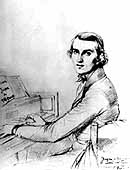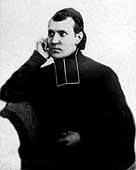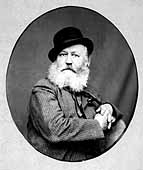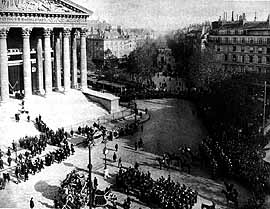|

|
You will find on this page a remarkable
summary of Charles Gounod's career wrote by Mrs
Marie-Hélène Coudroy-Saghaï,
Head of Research at the National Superior Music
Conservatory of Paris. Why should I try myself on
the art of the conciseness, when others master this
exercise with talent. Many thanks to her. This text
is illustrated with contemporary photos and
paintings in order to better understand the
universe which was his. I am aware that the time
neede to read this page may be important, therefore
you can simply to save it to your hard drive with
your navigator, and read it leisurely when
disconnected.
|
GLANCE ON THE LIFE AND
WORKS OFCHARLES GOUNOD
He was born in Paris on June 18, 1818, in a family of
artists. Remarkable draftsman, painter of talent, his father
had occupied the function of professor at the Ecole
Polytechnique and Master teacher of drawing to the Pages of
Louis XVIII . His mother, excellent musician, had been
taught piano by Louis Adam and Hullmandel. Widowed in 1823,
she had to give piano lessons to provide for her children.
She taught Charles rudiments of music and he showed early
musical capacities.
During his years of study at the Saint Louis secondary
school, where he obtains his high school diploma of
philosophy in 1836, he attends the representation of
Rossini's Otello at the Theatre - Italien, as well as in
that of Mozart's Don Giovanni. These two masterpieces are
the major musical revelations of his youth. Gounod will have
all his life a fervent admiration for Mozart and will never
forget to celebrate his genius. The discovery of Beethoven's
Pastoral Symphony and the 9th with choirs, at the
Société des Concerts reinforces his musical
enthusiasm. Full of a high artistic ideal, young Charles has
the ambition to become a great composer. He is the pupil in
Halévy's conservatory for the fugue and the
counterpoint, and Lesueur's for the composition. In the Rome
competition , he takes second price in 1837 and two years
later, as a supreme consecration, first prize with the
cantata Fernande on a text of the count of Pastoret. Before
leaving for the villa Médicis in Rome where he was to
live during two years as prize-winner of the Institute,
Gounod composes for the mass anniversary of his Master
Lesueur, an Agnus Dei for 3 voices and choir, about which
Berlioz writes these prophetic lines: " Everything there is
new and distinguished: song, modulations, harmony. M. Gounod
proves here that one can expect everything from him ".
|
The departure for Rome is not easy, because the
young man leaves his beloved mother for the first
time. Heartily welcomed by Ingres, then director of
the Académie de France, they quickly become
close friends, the painter sharing an equal passion
for music. Gounod accompanies him on the piano in
sonatas for piano and violin of Mozart or Haydn,
introduces him to the Alceste of Lulli, or sings
with his wonderfully expressive voice his favorite
tunes. At Ingres asking, Gounod develops also his
gift for drawing, performing over a hundred
tracings from primitive subjects. The painter's
portrait of the young Gounod dates back to that
period. The musician reads Goethe's Faust and
composes melodies like "Le Vallon", "Le Soir", on
poems from Lamartine. The style is very personal,
and distinguishes itself from the romantic salon
music of the time by it's fluid prosody and
harmonic refinement. He is often seen at the
Sixtine Chapel where he bathes in Palestrina's art.
Sacred music spirits him, transports him. On the
other hand he finds the repertoire of the roman
theaters, limited to Donizetti, Bellini or
Mercadante, quite deceiving, unable to find there
"any musical profit to collect!". Gounod meets at
the Villa Medecis the singer Pauline Viardot, who
initiates him to the world of theater, as well as
introducing him to Fanny Hensel, Felix
Mendelssohn's sister. Outstanding pianist, she
introduces him to german music, "which troubles and
enthuses him".
|

Gounod par Ingres
|
Of an impressionable nature, he comes under the
influence of Father Lacordaire, a brilliant predicator, who
was in Rome to restore the order of the Dominicans. Under
his influence, Gounod will evolve towards social
Christianity and comes to think of embracing the
ecclesiastical state. This mystic crisis is amplified by his
friendship with Charles Gay, future bishop of Poitiers, who
had arrived in the last months of 1839 to prepare his
priesthood. From then on, Gounod dedicates himself to
religious music. He retires in the convent of San Benedetto
at Subiaco, to write a solemn mass, that he will have
performed in the church Saint-Louis-des Français on
May 1-st, 1841, day of Louis-Philippe the Ist's birthday,
the success of which gained him the title of lifetime
honorary choirmaster . For the first compulsory "flight", he
composes a Te Deum in the palestrinien style which Spontini,
in the official report of the Institute, sanctions in these
terms: " This composition lacks melodies, varied cantilenas
, motives, expression and melodious physionomy".
He leaves Rome " the serene, the pacifying " for Vienna
where musical life, theatrical or symphonic, is prosperous.
He goes, for the first time, to a representation of the
"Enchanted Flute", buids up relations with influential
artists and conducts, during the winter of 1842-43 , two of
his works, a Mass and a Requiem, in the Karlskirche. In
Berlin, he finds Fanny Hensel who introduces him to her
brother, who welcomes him by these words: " Oh! It's you the
madman my sister spoke to me about"! With his Gewandhaus
orchestra, Mendelssohn has him him to his Scottish Symphony,
and reveals to him, on the organ of the Thomaskirche, the
compositions of Bach. He judges his Requiem of Vienna "
worth of Cherubini " and advises him to write symphonic
music. Mendelssohn's work will stay for Gounod " the most
precious of models "

Gounod ecclésiastique
|
Back in Paris in May 1843, Gounod accepts the
position of musical director at the Church of
Foreign Missions. There, he imposes to the parish,
with some difficulty, the music of Bach and
Palestrina. During five years, he will shy away
from worldly seductions, writing exclusively
religious music. However, he befriends artists like
Gustave Courbet, Theophile Gautier, Gérard
de Nerval and, notably, the republican satirist
singer Pierre Dupont, even though he doesn't share
his political ideals. From October 1847 thru
february 1848, he wears the ecclesiastical frock
and signs his letters "l'Abbé Gounod".
Whilst working on a study of the compared history
of the religions, Gounod goes to the conferences of
Lacordaire at Notre-Dame, as well as theological
lectures at Saint Sulpice.
|
But the musician, then 30 years old, becomes aware
that " there is only one road to follow to become a name:
it's the theater ". Through the intervention of the
violinist Seghers, he contacts Pauline Viardot who had just
created with brightness Fidès's role in Meyerbeer's
"Prophet". She pushes him to write an opera, she takes the
initiative to impose by her commitment his first operatic
work, "Sapho", on Émile Augier's libretto. Even if it
meets only with a mild success, it brings the attention of
the public and the critics, who understand that it's not an
event but a coming. At the Comédie-Française,
he writes several entertainments for the "Bourgeois
Gentleman" as well as for "Ulysses", a tragedy with choirs,
directed by Jacques Offenbach when it opens in 1852. For the
first time, his partition was going to be published. " Saved
from oblivion! Nothing can give an idea of my joy " wrote
Gounod.
A short time after his marriage with Anna, daughter of
Joseph Zimmerman, composer and piano teacher at the
Conservatoire, Gounod is named director of the Paris Brass
band, choral institution recruiting in the working class,
then one year later, in 1853 , director of singing education
of the Paris municipal schools. These functions which he
assumes with dedication give him the opportunity to write
numerous choral and religious works, among which the "Mass
for Orphéonistes" played in Saint-Germain-l'Auxerrois
in June1853, under his direction.

Le Chalet à Saint-Cloud
|
After his father in law's death, he moves into
their property in Saint Cloud, where he will reside
most of his life. That same year, his famous Ave
Maria, already popular, will have an enormous
success in the orchestrated version. Gounod
composes a new national anthem "Vive l'Empereur" in
honor of Napoleon III, and has sung by 1500 voices
at the Universal Exposition of 1855. After the
failure of his second lyrical work "La Nonne
Sanglante", he resumes work on his Faust,
originally conceived in Rome. Overworked, victim of
a bad case of nervous breakdown, which he was prone
to, he is interned in the famous hospital of Dr
Blanche. After a period of forced rest, he compose
a masterpiece of wit and vigor, Le Medecin
malgré Lui.
|
Faust is finished, but because of competition with
the theater of the Porte Saint Martin, showing a drama on
the same subject, it will only open in 1859 at the
Théatre-Lyrique. Considered more exercised than
inspired, more symphonic than melodic, Faust does not gain
immediate success. Actually, this opera of half character,
in which the vocal virtuosity gives way to a burning melodic
lyrism, breaks with the beautiful italian canto and
meyerberian effects, so appreciated by the public. He
privileges Marguerite's character, painting the deep
feelings of her soul. " When I compose, says Gounod, I am
penetrated with the feeling, the words, with the character
of the person, and I let my heart speak". According to
tradition, the composer has to add a ballet for the
representation of his work at the Opera in 1869; resolving
to it, he assumed " his humbling profession of decomposer of
music ". Enjoying universal popularity, Faust symbolizes the
flourish of the French lyric art.
Gounod resigns from his position at the Brass band, and
writes two light operas, "Philémon et Baucis" and "La
Colombe", on a libretto of Jules Barbier and Michel
Carré, his official librettists. Although judged as
models of taste and sharpness, the two works not more
successful than his opera "La reine de Saba". He turns back
to poetic opera, better adapted to his lyric vein, and comes
out with "Mireille" based on Mistral, and "Roméo et
Juliette".
Happy to leave Paris which " suffocates and chokes him",
he composes in the South of France, in order to bathe in the
atmosphere in which his characters evolve. Created at the
Théatre-Lyrique in 1867, Roméo and Juliette,
who raises unanimous enthusiasm, marks the highlight of the
dramatic career of the composer. Exhausted nervously by this
period of intense creative activity, Gounod looks once more
for peace and isolation in Rome, his preferred retreat,
where he would have always wanted to live. He lets his
religious fervour run free by sketching a " Christian opera
" "Polyeucte".
|
But the Franco-Prussian war of 1870 puts a halt
to the composition of this work he is so fond of.
Overwhelmed by the state of France, unable to "live
under the ennemy's flag", Gounod takes refuge in
England with his family. He will meet there the
singer Georgina Weldon, who will have a strong
influence on him (ascendant absolu), convincing him
to act in ways totally in opposition with his
nature. And thus, he becomes her
"protégé" during three years, at
Tavistock House, composing without respite, suing
constantly his publishers and, finally, refusing
the position of director of the Conservatoire de
Paris. Tired, sick, Gounod finally leaves London
with the help of Dr. Blanche and a few friends. He
abandons there a few manuscripts, notably
"Polyeucte", conficated in vengeance by Georgina
Weldon. Back in France, he will retranscript the
entire work from memory, with a prodigious
accuracy. Very depressed by the failure of this
opera which, more than any other, is the reflection
of his inner convictions, Gounod said:" May all my
works perish, may my Faust perish, but Polyeucte
must be revived and must live."
|

Gounod à la mode Londonienne
|
Thinking only of:" turning to the sky all his
forces of contemplation ", the musician works "almost
reluctantly" on his ultimate dramatic work "Le Tribut de
Zamora", and composes two oratorios, "Redemption" ( 1882 )
and "Mors et Vita" ( 1885 ), not devoid of theatrical
effects. In the last years of his life, he will displays a
rich and varied literary activity, becomes a critic also ,
writing in defence of Saint-Saens at the creation of "Henry
VIII" and "Proserpine" . With tireless vitality, supervises
the last rehearsals of his works, which he conducts most of
the time. The concert at the Chatelet on April 4, 1890,
where he conducts his works to a triumphant success, marks
his last public appearance. Laden with honors and
decorations, Gounod had till the end his easygoing
temperament, always ready to seduce. Stimulated by kindness,
devoted to those who come to him, he creates instinctively
around him a current of sympathy and affection which he
needs so profoundly . In spite of a failing health, he
attends the concerts of sacred music by the Singers de
Saint-Gervais, begins a musical diptych on Saint
François d'Assise and writes his last melody "Tout
l'Univers obéit à l'Amour".

Obsèques nationales en l'église de
la Madeleine
|
Stroked while composing a Requiem in the memory
of a grandson, Gounod dies in Saint-Cloud on
October 17, 1893. National burial takes place at
the Madeleine, where, according to his wish, a
Gregorian mass is sung. Gounod will remain forever
the musician of love " whose immense sigh goes away
to get lost in infinity ".
|
Marie-Hélène
Coudroy-Saghaï
in charge of research at the
National Superior Music Conservatory of Paris
|
|


